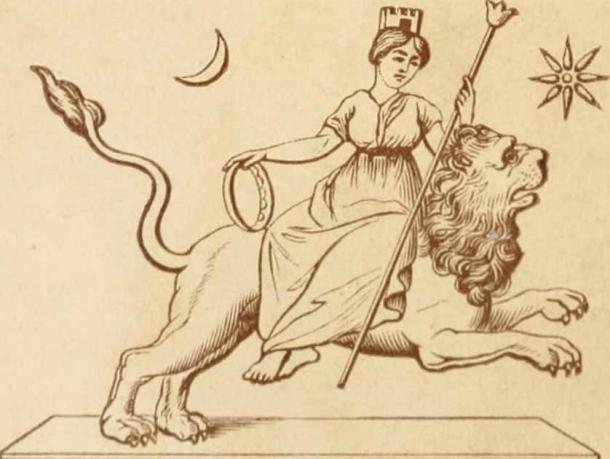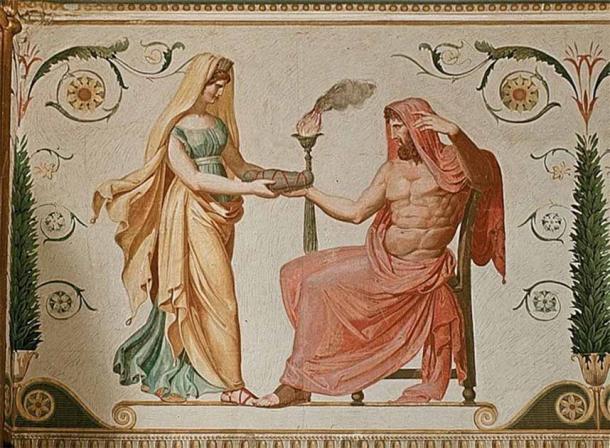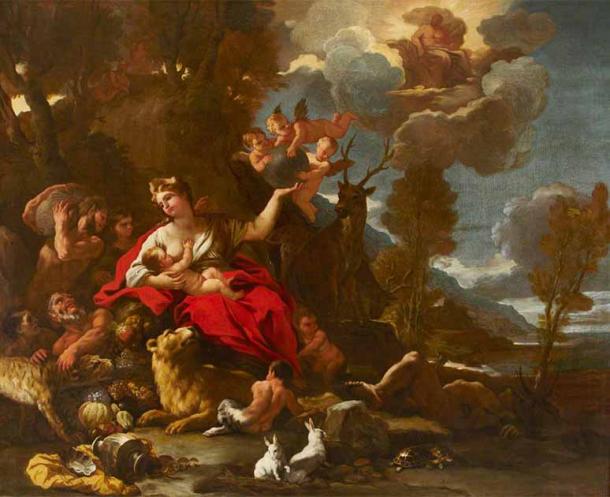
Greek Goddess Rhea: Mother of the Gods & Queen of the Titans
Rhea is one of the most important ancient Greek gods. Although a Titan, she was responsible for both the birth and survival of the most famous Greek Gods such as Zeus and Hera. However, today while people with even a passing knowledge of Greek mythology know many Greek gods’ names, Rhea rarely gets the respect she deserves. Learn more about Rhea, Mother of the Gods, and Queen of the Titans.
Rhea in Mythology
Most major Greek gods have long and complicated histories. Most of the Titans on the other hand do not; they’re usually little more than narrative devices used to introduce more important gods. Rhea is interesting because she sits somewhere in between. She plays an important enough role to receive more characterization than the other Titans, but she doesn’t appear in many myths.

Depiction of Rhea riding a lion. (Public Domain)
The Dysfunctional Titan Family
The family tree of the gods is a complicated and incredibly incestuous one. Greek mythology begins with the two primordial parents, Uranus and Gaia. Uranus represented the sky while Gaia represented the Earth. Greek mythology gets incredibly complicated, with different ancient historians and poets giving different takes on the same old tales. For the sake of simplicity, we will focus on Hesiod’s telling, naming other versions where and when applicable.
Uranus and Gaia (depending on the version) had quite a few children together. The most important were the 12 (or 13) Titans: Oceanus, Coeus, Crius, Hyperion, Iapetus, Cronus and the Titanides- Theia, Rhea, Thermos, Mnemosyne, Phoebe, and Tethys.
In addition to the Titans, they had various monsters together, such as the Cyclopes, the Hecatoncheires (three massive 50-headed, hundred-handed giants), giants, Meliae (nymphs), and the Erinyes (also known as the Furies, female gods of vengeance).
In the most common versions of the myth, such as Hesiod’s, Uranus feared his children would rise up against him, and so he imprisoned them. Uranus was right to be worried. As soon as he came of age, his youngest son, Cronus, rebelled, and overthrew Uranus with the help of his mother.
In doing so, he became king of Titans and freed his siblings. To celebrate, Cronus married his sister, Rhea. Rhea and Cronus would go on to have an infamously antagonistic marriage.
Thus followed the age of the Titans. The Titans were the gods prior to the Olympians, and ruled over land, sea, and sky together. Of all the Titans, Cronus and Rhea were the most important. Despite being brother and sister, they had children, and Rhea gave birth to the first Olympians: Zeus, Hades, Poseidon, Hestia, Demeter, and Hera.
This was not a happy coupling though. Both Gaia and Uranus warned Cronus that history would repeat itself. He would be overthrown by his children, like his father before him. Knowing from his own history that simply imprisoning his children was no guarantee of safety, Cronus opted for eating his offspring instead.
- The Unshakeable Power of Zeus, Prime Mover of Ancient Greek Deities
- Poseidon: Greek God of the Sea Who Created the Minotaur

Rhea, presenting a swaddled rock to Cronos by Karl Friedrich Schinkel; 1781-1841. (Public Domain)
Rhea, Mother of the Gods
Perhaps unsurprisingly Rhea did not take well to Cronus devouring her babies. Rhea teamed up with both Gaia and Uranus to hatch a plan to save the youngest child, Zeus. Rhea fled and gave birth to Zeus in a cave on the island of Crete. She then tricked Cronus with a rock wrapped in swaddling, which he quickly gobbled up.
Rhea hid her favorite son in a cave on Mount Ida, one of the two Greek sacred mountains. There, he was protected by the Kouretes and the Dactyls, two warrior races who worshipped the Titans. Zeus would later grow up and start the Titanomachy, the ten-year war between the Olympian gods and the Titans.
Aside from her role in raising Zeus, there are two other pre-Titanomachy myths that involve Cronus and Rhea. The first takes part while Zeus was still hidden away in Crete.
In this story, Rhea caught Cronus enjoying some time with his mistress Philyra (an Oceanid). Upon being discovered, Cronus panicked, transformed into a horse, and fled. His transformation into a horse in mid-coitus caused Philya to give birth to Chiron, usually mentioned as the first and greatest centaur.
The second myth focused on Rhea and Cronus is a story of married Greek gods actually working together for a change. In this story, the children of Oceanus take control of Mount Olympus at an early age and start to rule as the first gods. Cronus and Rhea can’t abide by this and decide to fight them. Ultimately, they throw them back into the ocean they came from. In this myth, Rhea is portrayed as a skilled wrestler.
Rhea after the Titanomachy
The Titanomachy ends with Zeus hurling his mighty lightning bolt at the Titans, defeating them and sending them plummeting into Tartarus (the part of the underworld saved for the wicked). However, it has never been clear exactly which Titans ended up in Tartarus besides Cronus.
Of the male Titans, it seems Oceanus remained free because he had helped the Olympians in their fight. It also seems apparent that the female Titans were allowed to remain free.
Rhea certainly remained free following the Titanomachy, since she crops up in several different myths. She is usually portrayed as having a somewhat antagonistic relationship with Zeus’ wife, her daughter Hera. Rhea had a habit of turning up to save her grandchildren.
Apollo was the bastard son of Zeus and Leto (Zeus’s previous wife and/or mistress). Hera, the goddess of childbirth, refused to attend Apollo’s birth out of jealousy/ spite, leaving Leto in agony. Rhea chose to attend the birth in Hera’s stead. As the original goddess of motherhood, Rhea’s presence eased Leto’s suffering.
Later, Dionysus (another bastard son of Zeus) was inflicted with madness by the spiteful Hera. When Dionysus’s mother died, Rhea took him under her wing and raised him. She later cured his madness and gifted him an amethyst that prevented drunkenness.
Rhea also made an important appearance in the story of Hades and Persephone. In most versions of the story, such as the Homeric Hymns, it is Rhea who visited Demeter after Persephone's kidnapping and persuaded her to meet with the Olympians to find a solution.
However, in one Orphic version of the myth, Rhea’s role was much more unpleasant. In this version, Zeus wished to marry his mother. Rhea refused his incestuous advances and transformed into a snake to escape him. This did little to deter Zeus, who responded by also taking the form of a serpent and raping his mother. Persephone is the result of this rape.
According to the Orphic myth, after Persephone’s birth, Rhea transformed and became Demeter. It could be that this version of the myth is an attempt to explain Rhea’s decreased prominence in Greek mythology after a certain point.
Etymology of the name Rhea
No one is entirely sure where the name Rhea comes from, but there are several popular theories. Some ancient etymologists believed Rhea came from the old Greek words for ground or earth. Some modern scholars have also supported this theory, pointing to the traditional connection between the portrayal of mother gods and the earth.
Other Greeks, such as Plato, pointed towards a different origin word for Rhea. Plato claimed Rhea was the feminine version of the Greek word rheō, for flow, discharge, or stream. The thought process here was that women sustain their babies through the flow of breast milk and experience the flow of blood during the menstrual cycle.
We will likely never know for certain the true etymology. Most modern etymologists support the flow theory, which is the one put forward in A Greek-English Lexicon.
Rhea and her Historical Twin Cybele
Ancient civilizations had a habit of adopting and/or bastardizing each other’s’ gods and mythology. As these civilizations interacted, they would take aspects of the religions they liked and incorporate them into their own.
Cybele is a prime example of this. Once her own entity, originating from Anatolia, by the 4th century BC, Rhea and Cybele's names were being used interchangeably in Greek literature and worship. As such, the attributes and depictions of the two goddesses became almost completely indistinguishable.

17th century oil painting of Cybele (Public Domain)
Both are usually depicted as wearing a tall crown or veil and sitting on a throne, surrounded by lions. When not sitting on a throne they are usually either riding a lion or on a chariot drawn by lions. Although both are depicted as mother gods, there are two important differences.
First, in her own mythology, Cybele was the Phrygian Great Mother, a universal mother. Rhea, on the other hand, was only ever portrayed as the mother of gods, not a universal mother. The Greeks had other mother deities on top of Rhea, like Gaia, Hera, and Demeter.
Second, their origins are very different. Cybele started her life as a hermaphrodite god called Agdistis. The other Phrygian gods feared Agdistis and cut off their male genitalia, creating the female mother god Cybele. The severed genitalia then grows into a beautiful young man from Phrygia named Agdistis. Cybele fell in love with Agdistis, but he was unfaithful so she drove him mad, causing him to castrate himself.
Although Cybele and Rhea are often closely linked, no part of Cybele’s hermaphrodite origin or love story with Agdistis ever made it into Rhea’s mythology. As time went on people simply tended to forget Cybele’s unique history, and she became synonymous with Rhea.
The Cult of Rhea
In general, the Titans didn’t get their own cults in ancient Greece and were not worshipped. They simply functioned as a genealogical origin story for the Olympian gods, whom the Greeks did worship. Rhea, however, is slightly different. Although she does not appear to have had a strong cult of her own, she does appear to have been worshipped, especially early on.
Rhea was first worshipped in Crete, the site of Zeus’ birth. Her worship here was loud, raucous, and rhythmic. Worshippers would dance to the sound of the tympanon (a large drum) to provoke religious ecstasy. The loud and energetic worship of Rhea is often connected to her role in raising Dionysus, whose worshippers were similarly enthusiastic.
The Greeks often called Rhea the “Mother of Gods” or Meter Theon. Several temples in ancient Greece appear to have been dedicated to Meter Theon. A Greek traveler and geographer from the second century AD named Pausanias mentioned temples located in Attika, Arkadia, Corinth, Olympia, and Athens dedicated to her. Besides her own temples, her role in birthing and then protecting the Olympians meant that statues of her often stood in the sanctuaries of other gods.
Conclusion
Rhea’s importance to Greek mythology cannot be underestimated. She played a major role not just in the birthing of the Olympian gods but also in the Titanomachy and the overthrow of the old gods. Next to Cronus, she is also one of the very few Titans who actually received any characterization and appears to have been the only Titan with her own loyal worshippers.
Rhea is also a rare example of positive female representation in Greek mythology. She is portrayed as the ultimate mother, betraying her cruel spouse to ensure the survival of her children. Hera the Olympian mother god is often portrayed as being cruel and jealous; however, Rhea is never portrayed in that way. Rhea repeatedly comes to the aid of the grandchildren that Hera seeks to punish.
Rhea truly deserved her name Meter Theo, Mother of the Gods.
Top image: Woman and lion drawing, representative of Rhea. Source: jozefklopacka/ Adobe Stock
By Robbie Mitchell
References
Greenberg. M. 2020. Rhea: The Mother of Gods. Mythology Source. Available at: https://mythologysource.com/rhea-greek-goddess/
Kapach, A. 2022. Rhea. Mythopedia. Available at: https://mythopedia.com/topics/rhea
Smith. W. 1873. Dictionary of Greek and Roman Mythology. London.
Tolentino. C. 2022. Rhea: The Mother Goddess of Greek Mythology. History Cooperative. Available at: https://historycooperative.org/rhea-greek-mother-goddess/
















Comments
Cronus is not only associated with Saturn, Cronus is Saturn, just a differing name for the same planet.
Earth is in the process of being ruined and when it is final we will have nowhere to go as we have ruined the rest. You cannot drill so many holes in a planet and then suck the life blood from that planet and not expect any consequences, daft hey!
The most intriguing part of the story is Uranus warning his son, Cronus, who is associated with Planet Saturn, about Jupiter, aka Zeus. Of course, that is the order the planets are in. Next one would be Mars, and then Earth. The surface of Mars appears lifeless, possibly in ruins. Earth was also once in ruins. Makes you wonder.
Nobody gets paid to tell the truth.